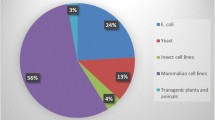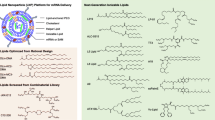Abstract
In an effort to initiate the development of a plant-based vaccination model against atherosclerosis, a cholera toxin B subunit (CTB)-based chimeric protein was designed to target both ApoB100 and CETP epitopes associated with immunotherapeutic effects in atherosclerosis. Epitopes were fused at the C-terminus of CTB to yield a protein called CTB:p210:CETPe. A synthetic gene coding for CTB:p210:CETPe was successfully transferred to tobacco plants with no phenotypic alterations. Plant-derived CTB:p210:CETPe was expressed and assembled in the pentameric form. This protein retained the target antigenic determinants, as revealed by GM1-ELISA and Western blot analyses. Higher expresser lines reached recombinant protein accumulation levels up to 10 µg/g fresh weight in leaf tissues and these lines carry a single insertion of the transgene as determined by qPCR. Moreover, when subcutaneously administered, the biomass from these CTB:p210:CETPe-producing plants was able to elicit humoral responses in mice against both ApoB100 and CETP epitopes and human serum proteins. These findings evidenced for the first time that atherosclerosis-related epitopes can be expressed in plants retaining immunogenicity, which opens a new path in the molecular farming field for the development of vaccines against atherosclerosis.









Similar content being viewed by others
References
Tabas, I., Williams, K. J., & Boren, J. (2007). Subendothelial lipoprotein retention as the initiating process in atherosclerosis: Update and therapeutic implications. Circulation, 116, 1832–1844.
Hartvigsen, K., Chou, M. Y., Hansen, L. F., Shaw, P. X., Tsimikas, S., Binder, C. J., et al. (2009). The role of innate immunity in atherogenesis. Journal of Lipid Research, 50(Suppl.), S388–S393.
Feig, J. E., Shamir, R., & Fisher, E. A. (2008). Atheroprotective effects of HDL: Beyond reverse cholesterol transport. Current Drug Targets, 9, 196–203.
Perreault, S., Blais, L., Lamarre, D., Dragomir, A., Berbiche, D., Lalonde, L., et al. (2005). Persistence and determinants of statin therapy among middle-aged patients for primary and secondary prevention. British Journal of Clinical Pharmacology, 59, 564–573.
Bates, T. R., Connaughton, V. M., & Watts, G. F. (2009). Non-adherence to statin therapy: A major challenge for preventive cardiology. Expert Opinion on Pharmacotherapy, 10, 2973–2985.
Fredrikson, G. N., Andersson, L., Söderberg, I., Dimayuga, P., Chyu, K. Y., Shah, P. K., et al. (2005). Atheroprotective immunization with MDA-modified apo B-100 peptide sequences is associated with activation of Th2 specific antibody expression. Autoimmunity, 38, 171–179.
Schiopu, A., Bengtsson, J., Söderberg, I., Janciauskiene, S., Lindgren, S., Ares, M. P., et al. (2004). Recombinant human antibodies against aldehyde-modified apolipoprotein B-100 peptide sequences inhibit atherosclerosis. Circulation, 110, 2047–2052.
Klingenberg, R., Lebens, M., Hermansson, A., Fredrikson, G. N., Strodthoff, D., Rudling, M., et al. (2010). Intranasal immunization with an apolipoprotein B-100 fusion protein induces antigen-specific regulatory T cells and reduces atherosclerosis. Arteriosclerosis, Thrombosis, and Vascular Biology, 30, 946–952.
Chyu, K. Y., Zhao, X., Dimayuga, P. C., Zhou, J., Li, X., Yano, J., et al. (2012). CD8+ T cells mediate the athero-protective effect of immunization with an ApoB-100 peptide. PLoS ONE, 7, 1–12.
Rittershaus, C. W., Miller, D. P., Thomas, L. J., Picard, M. D., Honan, C. M., Emmett, C. D., et al. (2000). Vaccine-induced antibodies inhibit CETP activity in vivo and reduce aortic lesions in a rabbit model of atherosclerosis. Arteriosclerosis, Thrombosis, and Vascular Biology, 20, 2106–2112.
Davidson, M. H., Maki, K., Umporowicz, D., Wheeler, A., Rittershaus, C., & Ryan, U. (2003). The safety and immunogenicity of a CETP vaccine in healthy adults. Atherosclerosis, 169, 113–120.
Thomas, L., Hammond, R., Forsberg, E., Geoghegan-Barek, K., Karalius, B., Marsh, H., et al. (2009). Co-administration of a CpG adjuvant (VaxImmuneTM, CPG 7909) with CETP vaccines increased immunogenicity in rabbits and mice. Human Vaccines, 5, 79–84.
Gaofu, Q., Jun, L., Xiuyun, Z., Wentao, L., Jie, W., & Jingjing, L. (2005). Antibody against cholesteryl ester transfer protein (CETP) elicited by a recombinant chimeric enzyme vaccine attenuated atherosclerosis in a rabbit model. Life Sciences, 77, 2690–2702.
Barter, P. J., Hopkins, G. J., & Calvert, G. D. (1982). Transfers and exchanges of esterified cholesterol between plasma lipoproteins. Biochemical Journal, 208, 1–7.
von Eckardstein, A., Nofer, J. R., & Assmann, G. (2001). HDL and coronary heart disease: Role of cholesterol efflux and reverse cholesterol transport. Arteriosclerosis, Thrombosis, and Vascular Biology, 20, 13–27.
Curtis, R. I., & Cardineau, C. A. (1990). Oral immunization by transgenic plants. World Patent Application. WO 90/02484.
Yusibov, V., Streatfield, S. J., & Kushnir, N. (2011). Clinical development of plant-produced recombinant pharmaceuticals. Vaccines, antibodies and beyond. Human Vaccines, 7, 313–321.
Mason, H. S., & Herbst-Kralovetz, M. M. (2012). Plant-derived antigens as mucosal vaccines. Current Topics in Microbiology and Immunology, 354, 101–120.
Santi, L., Batchelor, L., Huang, Z., Hjelm, B., Kilbourne, J., Arntzen, C. J., et al. (2008). An efficient plant viral expression system generating orally immunogenic Norwalk virus-like particles. Vaccine, 26, 1846–1854.
Lawson, L. B., Norton, E. B., & Clements, J. D. (2011). Defending the mucosa: Adjuvant and carrier formulations for mucosal immunity. Current Opinion in Immunology, 23, 414–420.
Salazar-González, J. A., & Rosales-Mendoza, S. (2013). A perspective for atherosclerosis vaccination: Is there a place for plant-based vaccines? Vaccine, 31, 1364–1369.
Cangelosi, G. A., Best, E. A., Martinetti, G., & Nester, E. W. (1991). Genetic analysis of Agrobacterium. Methods in Enzymology, 204, 384–397.
Horsch, R. B., Fry, J. E., Hoffmann, N. L., Eichholtz, D., Rogers, S. G., & Fraley, R. T. (1985). A simple and general method for transferring genes into plants. Science, 227, 1229–1231.
Dellaporta, S. L., Wood, J., & Hicks, J. B. (1983). A plant DNA minipreparation: Version II. Plant Molecular Biology Reporter, 1, 19–21.
Weng, H., Pan, A., Yang, L., Zhang, C., Liu, Z., & Zhang, D. (2004). Estimating number of transgene copies in transgenic rapeseed by real-time PCR assay with HMG I/Y as an endogenous reference gene. Plant Molecular Biology Reporter, 22, 289–300.
Chikwamba, R., Cunnick, J., Hathaway, D., McMurray, J., Mason, H., & Wang, K. (2002). A functional antigen in a practical crop: Maize synthesized LT-B protects mice against Escherichia coli heat labile enterotoxin (LT) and cholera toxin (CT). Transgenic Research, 11, 479–493.
Gaofu, Q., Jingjing, L., Shengying, W., Shanshan, X., Peng, D., Qingye, Z., et al. (2011). A chimeric peptide of intestinal trefoil factor containing cholesteryl ester transfer protein B cell epitope significantly inhibits atherosclerosis in rabbits after oral administration. Peptides, 32, 790–796.
Ruhlman, T., Ahangari, R., Devine, A., Samsam, M., & Daniell, H. (2007). Expression of cholera toxin B-proinsulin fusion protein in lettuce and tobacco chloroplasts—oral administration protects against development of insulitis in non-obese diabetic mice. Plant Biotechnology Journal, 5, 495–510.
Youm, J. W., Jeon, J. H., Kim, H., Kim, Y. H., Ko, K., Joung, H., et al. (2008). Transgenic tomatoes expressing human beta-amyloid for use as a vaccine against Alzheimer’s disease. Biotechnology Letters, 30, 1839–1845.
McCormick, A. A., Reddy, S., Reinl, S. J., Cameron, T. I., Czerwinkski, D. K., Vojdani, F., et al. (2008). Plant-produced idiotype vaccines for the treatment of non-Hodgkin’s lymphoma: Safety and immunogenicity in a phase I clinical study. Proceedings of the National Academy of Sciences of the United States of America, 105, 10131–10136.
Kim, T. G., Gruber, A., & Langridge, W. H. (2004). HIV-1 gp120 V3 cholera toxin B subunit fusion gene expression in transgenic potato. Protein Expression and Purification, 37, 196–202.
Lee, J. Y., Yu, J., Henderson, D., & Langridge, W. H. (2004). Plant-synthesized E. coli CFA/I fimbrial protein protects Caco-2 cells from bacterial attachment. Vaccine, 23, 222–231.
Sharma, M. K., Singh, N. K., Jani, D., Sisodia, R., Thungapathra, M., Gautam, J. K., et al. (2008). Expression of toxin co-regulated pilus subunit A (TCPA) of Vibrio cholerae and its immunogenic epitopes fused to cholera toxin B subunit in transgenic tomato (Solanum lycopersicum). Plant Cell Reports, 27, 307–318.
Li, D., O’Leary, J., Huang, Y., Huner, N. P., Jevnikar, A. M., & Ma, S. (2006). Expression of cholera toxin B subunit and the B chain of human insulin as a fusion protein in transgenic tobacco plants. Plant Cell Reports, 25, 417–424.
Greco, R., Michel, M., Guetard, D., Cervantes-Gonzalez, M., Pelucchi, N., Wain-Hobson, S., et al. (2007). Production of recombinant HIV-1/HBV virus-like particles in Nicotiana tabacum and Arabidopsis thaliana plants for a bivalent plant-based vaccine. Vaccine, 25, 8228–8240.
Rigano, M. M., Dreitz, S., Kipnis, A. P., Izzo, A. A., & Walmsley, A. M. (2006). Oral immunogenicity of a plant-made, subunit, tuberculosis vaccine. Vaccine, 24, 691–695.
Kim, S. I., Veena, J. H., & Gelvin, S. B. (2007). Genome-wide analysis of Agrobacterium T-DNA integration sites in the Arabidopsis genome generated under non-selective conditions. Plant Journal, 51, 779–791.
Tse, K., Gonen, A., Sidney, J., Ouyang, H., Witztum, J. L., Sette, A., et al. (2013). Atheroprotective vaccination with MHC-II restricted peptides from ApoB-100. Frontiers in Immunology, 4, 493.
Baldwin, I. T. (1988). Damaged-induced alkaloids in tobacco: Pot-bound plants are not inducible. Journal of Chemical Ecology, 4, 1113–1120.
Acknowledgments
Projects from the group were funded by Grants from CONACYT (102109/56980), PROMEP-2010 to Bioprocess CA. Omar González corrected the English version of the manuscript.
Author information
Authors and Affiliations
Corresponding author
Additional information
Jorge Alberto Salazar-Gonzalez and Sergio Rosales-Mendoza have contributed equally to this work.
Rights and permissions
About this article
Cite this article
Salazar-Gonzalez, J.A., Rosales-Mendoza, S., Romero-Maldonado, A. et al. Production of a Plant-Derived Immunogenic Protein Targeting ApoB100 and CETP: Toward a Plant-Based Atherosclerosis Vaccine. Mol Biotechnol 56, 1133–1142 (2014). https://doi.org/10.1007/s12033-014-9793-6
Published:
Issue Date:
DOI: https://doi.org/10.1007/s12033-014-9793-6




